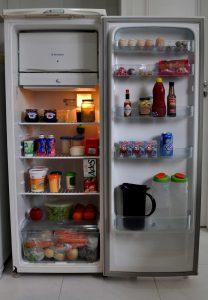In 2018, one in six Americans got sick from eating contaminated food.
That figure comes from a Centers for Disease Control and Prevention (CDC) report. And, remember, that only accounts for reported cases of sickness.
Clearly, food safety concerns everyone. That’s especially true during and after a disaster, such as a hurricane, when water supplies might be contaminated and power outages make it difficult to keep and prepare fresh, safe food
So, what should you do?
The basics, of course.
Wash your hands

Food safety always starts with handwashing. Just like handwashing is vital to slowing the spread of COVID-19, the first defense against foodborne pathogens comes via a good, 20-second (or longer) scrub of your hands, followed by drying them on a clean towel or, better yet, a paper towel.
Purify water
You’ll also want to focus on the water. If your water supply has become contaminated or there is a broken water line that could allow contaminants, do you know how to purify your water? It is a three-step process:
- Bring water to a roiling boil for 3-4 minutes,
- Chlorinate the water, carefully, using 2-4 drops of unscented bleach per quart (4 cups) of water, and
- Let water sit undisturbed for 30 minutes before use.
Note that boiling the water so vigorously actually removes air from the liquid. So, you might want to re-aerate it by pouring the liquid back and forth between two sanitized containers.
Sanitize surfaces
Make sure to sanitize any surfaces or equipment that might contact foods, especially if flood water or rain has entered your home. Any of the following options would work:
- Mix 1 gallon of water with 1 tablespoon of unscented, liquid chlorine bleach and place in a well-marked container. The solution will maintain its integrity for about 5 or 6 days.
- Heat 4 ounces (1/2 cup) of white distilled vinegar OR hydrogen peroxide in a sauce pan, bringing temperature up to 150 degrees Fahrenheit (the heated liquid likely will have an unpleasant though non-harmful odor), and transfer to a well-marked spray bottle for immediate use. Caution: Never mix vinegar AND hydrogen peroxide.Use on kitchen surfaces, sinks, faucets and refrigerator interior parts by spraying the warm liquid on, letting stand for one minute, and then wiping away with a clean paper towel. As a good practice, test the sanitizer in an unseen place to make sure hydrogen peroxide will not discolor or fade surfaces.
- Pour 4 ounces (1/2) cup of white distilled vinegar OR hydrogen peroxide (Caution: Never mix vinegar AND hydrogen peroxide) directly into a spray bottle and use at room temperature. Use on kitchen surfaces, sinks, faucets and refrigerator interior parts by spraying the liquid on, letting stand for 10 minutes, and then wiping away with a clean paper towel. Again, test the sanitizer in an unseen place to make sure hydrogen peroxide will not discolor or fade surfaces.
Cold storage temperatures
Do you know what temperature your refrigerator is set at? Your freezer? Hopefully, you do. And, hopefully that temperature setting is in the 35-40 degrees Fahrenheit range for the refrigerator and 0 degrees for the freezer. Those are the ideal settings for food storage.
But, what do you do if you lose power?
 First, keep your refrigerator door closed as much as possible. Refrigerated foods will stay safe for cooking and consumption for just 2-4 hours once power goes out. Foods in a full freezer will hold for roughly 48 hours, while foods in a half-full freezer will maintain a safe temperature for just 24 hours.
First, keep your refrigerator door closed as much as possible. Refrigerated foods will stay safe for cooking and consumption for just 2-4 hours once power goes out. Foods in a full freezer will hold for roughly 48 hours, while foods in a half-full freezer will maintain a safe temperature for just 24 hours.
Keep a thermometer in the freezer to make sure the temperature doesn’t rise above 40 degrees. If the temperature climbs above that mark, throw out foods from the freezer. If you don’t have a thermometer, you can check for ice crystals on the foods, an indicator they are still cold enough for safe preparation.
To prepare for a possible power outage that impacts your refrigerator/freezer, follow these steps:
- Set your refrigerator and freezer to a colder setting a few days prior to the storm.
- Transfer your lunchmeats, poultry etc. from your refrigerator and into the freezer a day or two ahead of the storm’s expected arrival.
- Freeze some plastic gallon jugs filled with water, and use as cold-storage tools. Note: Do not freeze full jugs, which might expand and burst. And, freeze just one jug per day, to avoid overtaxing your freezer.
What to eat, when
If the power goes, even though you’ve taken precautions, you’ll need to plan out which foods you eat and in what order. Generally,
- FIRST, eat from your refrigerator; all the perishable foods. To be safe, you have 2-4 hours.
- SECOND, start consuming foods from your freezer. If the door remains closed, you have 2-4 days for foods to stay safe.
- THIRD, use those non-perishable foods you have stockpiled.
Food temperatures
One last item to tackle with food safety: always cook your food to the proper internal temperatures. Freezing prevents bacteria from multiplying, but only heating food to proper temperatures will kill the illness-causing pathogens. Get into the habit of using a food thermometer. Foods might look cooked on the outside but that can be deceiving. Only a thermometer can tell you with certainty if you’ve reached a safe-to-eat food temperature. If you are unsure of the proper internal temperature or don’t have a chart to guide you, then the rule-of-thumb is to cook to an internal temperature of 165 degrees Fahrenheit.
Suffering a foodborne illness while dealing with a disaster can be miserable. Follow the steps to ensure you and your family are eating foods that have been stored properly prepared on sanitized surfaces and cooked to their proper internal temperatures.
Oh, one last thing…
“When in doubt, throw it out!”
RESOURCES
For more information on disaster planning visit the following resources:
- scgov.net/government/emergency-services/hurricane-preparedness
- floridadisaster.org
- tampabayprepares.org
- ready.gov
Other posts in this series:
 0
0
